[ Scroll for the full story ]
Baja redux
In January 2006 I rode down the Baja one more time — 1,100 miles from the border with California to the tip of the peninsula. I rode the same bike on which I took the trip in 2001 — a 1995 FLHT-C — albeit with a new re-manufactured engine from Harley-Davidson, since my original engine blew the rear cylinder at 103,000 miles (165,000 kilometers).
Although I don’t anticipate that the roads will be any worse than in 2001, I installed new tires front and rear.
Check here for some general information on the Baja and on permits required for the trip.
In 2001, I was accompanied by a good friend on my Baja Run. Don was a great guy and a great old-school motorcyclist. In 2004 Don passed away, consequently this trip will be a memorial to him. I won’t dwell on his passing here because during my ride I know that he’ll be looking down and smiling.
Fuel, food, checkpoints and topes
The fuel was all good. Occasionally, you might have to buy it from a roadside 45-gallon drum — as in Catavina — but even then, I experienced no problems.
As always, the food was excellent.
The military checkpoints are normally breezed through with no problems. Smile, shake your head and say, “No hablo espanol,” and you’ll be on your way. Occasionally, they’ll want to look in a bag or saddlebag. Let them. You’re not in North America now.
Topes, or speed bumps, are another matter entirely. Don’t hit these things at speed or you’ll be launched into the air. Sometimes they appear out of nowhere, like an old girlfriend. Try to slow down in time.
Baja bullshit
A lot of people who have never visited the true Baja south of the border tourist towns have some pretty negative opinions about the place. Give it a chance.
Go. Relax. Enjoy.
Don’t listen to the “My friend, cousin, neighbor, brother, aunt, uncle went there and it was horrible” stories. Yes, there are some of those, but for every one, there are thousands of good stories.
Life is an adventure. Live your own.
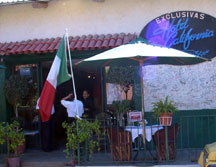
It started out uneventful enough, but no, as luck would have it I had to ride over to Yuma to pick up a part. Nothing serious, just a delay in the proceedings until the next day.
Across the line a brief stop was required to get my tourist visa (ask for 180 days, and make it the standard in case they offer less). That’s a simple form fillout that the girl did for me. She asked for my passport, and kept it as she sent me across the road to the Banjercito office to pay the bill. I brought the receipt back, she stamped my passport and handed it back to me complete with my tourist permit. I was on my way.
No vehicle permit is required for crossing into and riding down the Baja. You will need one for the mainland, should you choose to cross there.
Once into Mexicali, it’s a matter of paying attention to the road signs. Believe me, pay attention. There are two M2 routes. The first is the old two lane ‘free’ highway, and the second is the M2 divided toll road. This second road out of town is a bit hard to follow given the lack of noticeable road signs. I had to backtrack a couple of times because the signs were hidden or pointing in the wrong direction, most notably at a traffic circle to the west of city center.
Out of town to the west, things pick up. The four lane M2 is good, but watch out for slippery spots. Anti-freeze, oil and other unknown substances seem to leak out here and there. Once on a corner hill I felt my rear tire give up traction for a split second. Had I been speeding, I could have ended up in the ditch, I’m sure.
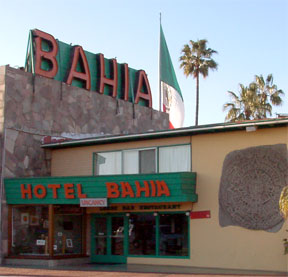
Traffic appeared to be very light on this road, probably because of the toll.
This road winds and twists and climbs to the west and then descends all the way to Tecate, where I had to go a fair distance into town for fuel. On the way back out, make a right turn at the fire department buildings and you’ll be back on your way to Ensenada via M3.
While good, this road is a narrow two lanes and drops off spectacularly on the sides. There’s lots of truck traffic too, so take care. And, in case you’re wondering, yes, people do pass on corners and hills even though they aren’t able to see oncoming traffic. Keep an eye out and corner appropriately, no matter what, on this narrow road. Because I did that, I narrowly missed a head-on with a car passing on a hilly turn.
At El Sauzal the M3 runs into M1, and before you know it you’re on the outskirts of Ensenada. Keep to the right, read the signs, and you’ll be at a Pemex station if you want to get fuel here. If not, don’t worry, because there are plenty of Pemex stations on the way out of town to the south.
I elected to hook up with Avenue Lopez Mateos and park in front of the Hotel Bahia. It’s an older two storey hotel right downtown, with plenty of places to eat nearby. I had phoned ahead and booked a room. Price quoted – U$59.00. Price negotiated on the phone – U$39.00. During check-in I got a ticket for a free margarita in their bar. I enjoyed that after a long day in the saddle, believe me.
Parking at the hotel is in back, but the desk attendant told me I could park right beside the outdoor bar, so I wheeled up to within about 20 feet of the hotel’s back door, parked for the night and unloaded.
The room wasn’t anything fancy, but it did have a small balcony overlooking the sea to the west. You have a choice of carpeted rooms upstairs, or no carpet downstairs. And, they offered a ticket to a continental breakfast in the morning at a restaurant just a couple of doors away. The Hotel Bahia is popular with the biker crowd, so be aware that during rallies you may not be able to get a room here.
Hussong’s and everything else is within a short walk, so see the sights and try to avoid buying trinkets, because if you’re headed south, it’s a long way to be hauling goodies for the folks back home.
Calling cards
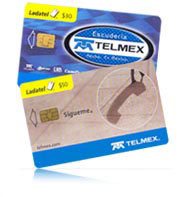
The one thing I do recommend is that you avoid at all costs the ‘direct line’ phone booths where they want your credit card for a call. Instead, buy a Ladatel or Telmex card in 30, 50 or 100 peso amounts. These phone cards can be found in the small stores up and down the shopping districts. If one store is out of them, another will have them. Sometimes there’s even bonus minutes added the first time you use the card.
Insert your card, wait for the prompt which shows how much is left on the card, and punch in 001 + area code + phone number to call any number in North America. After you hang up, that beeping noise is to remind you to remove the card.
The Ladatel/Telmex phone booths are found almost everywhere in the Baja. (Although not in Cataviña.)
After a continental breakfast just up the street from the Hotel Bahia, I walked back, checked out and got my five dollars back on the key deposit. I pushed out early from the bar in back of the hotel and rode Avenue Lopez Mateos south to the highway. There are plenty of Pemex stations on the way south out of the city, and no shortage of fuel. Traffic is hectic, but that’s the same in any city.
I took a side trip to the end of the winding road at La Bufadora. The ride was interesting, but I didn’t feel like paying for parking in the tourist trap town. The vendor stalls weren’t open yet, but I could tell by the number of them that this place was popular with the tourists. I turned around and rode back the way I came.
Every town on the road south is dusty. If there’s a wind, there are dust devils. If the town is large enough, businesses line the highway fifty or a hundred feet back. Cars struggle to scramble over the edge of the pavement to get to them. In towns, topes or speed bumps slow and interrupt the flow of traffic, so watch out. Many aren’t well marked. Hitting one of these and speed will launch you high into the air if you’re not careful.
After fueling in El Rosario, the last town on the Pacific side of the Baja, the road turns inland away from the Pacific. It was only 54F (12C) when I pulled out of Ensenada at sunrise, and it didn’t warm up until the road traveled farther inland, finally making 80F (26C) by the time I hit Cataviña and the Desert Inn there.
The Desert Inns chain (formerly the La Pinta chain) has hotels in Ensenada, San Quintin, Cataviña, Guererro Negro, San Ignacio and Loreto, each complete with restaurants and bars. They’re pretty nice places to stay, given that they’ve been around since the highway was completed in 1973.
The Pemex beside the Cataviña Desert Inn was closed (as it was during my ride in 2001) but I was told that it was “open last month”. Never fear though, there’s always a privateer wanting to make a little cash, and just 100 feet away was someone selling gas out of a drum for 35 pesos a gallon. He was even wearing a Harley t-shirt!
Chocolate bar impresario
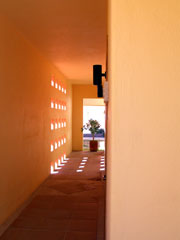
For comic relief I started up a conversation with a disheveled gringo who was hanging around the gas stop. He informed me that he had been the inventor of a well-known chocolate treat — “Reeses Pieces” but with jam rather than peanut butter, if you can believe it. His story was that he had been cheated out of millions when the peanut butter treat came on the market. I gave him 10 pesos for his story and he was happy to go away.
The hotel bar had Sol, so I was happy. I sat back and relaxed and had a couple of cold ones before dinner. A group of bikers arrived and joined me in the bar. They were waiting for some friends who had left after them, and would be arriving after dark. I didn’t envy those after-dark arrivals in the slightest. I retreated to the restaurant for a very nicely prepared spaghetti and chicken dinner. It was excellent. I retired early and slept like a log.
I had a morning meeting with myself and decided that I’d ride all the way to Loreto today, a trip of only 409 miles (659 km). On normal roads that wouldn’t be a difficult endeavor, but with this narrow Baja road, and the corners and hills farther south, I wasn’t so sure. No sightseeing today.
Twilight came at 0530 and I hit the road at 6. Just south of the La Pinta driveway was the first vado I had ever seen with running water in it. Since it hadn’t rained here, I wondered why the vado was full. I crossed carefully with no problem — the water was only an inch deep.
Guererro Negro was my next stop for fuel, but before that the highway again meets up with the Pacific side of the peninsula, and the cold air and thick-as-pea-soup fog I encountered cut to the bone. I had to stop and put on my rain pants to keep from getting chilled. At Guererro Negro I also lost an hour, as the time zone switches to Mountain here.
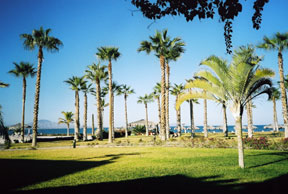
I stopped for fuel again in San Ignacio. I was going to spend the night here before proceeding on down to Loreto, but instead rode on to Mulege for more fuel.
Mulege is a bit of a pain with it’s one-way streets, but there is a Pemex in town. By now it’s up to 80 degrees again — a little warm to be in town, but not so bad out on the road. On the way out I discovered a new Pemex about four miles south of the town on the highway. Oh well.
North of Santa Rosalia, the road descends from the hills in a twisting downward spiral. Unbeknownst to me, a semi had stalled up-hill in the left lane on a blind corner. Fortunately I wasn’t going very fast, so I missed the line of semis that had already passed it in my lane. Just another reason for not speeding on this road even though it is good enough for high speed riding.
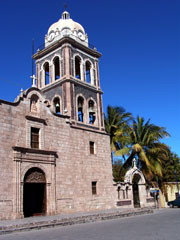
Finally Loreto came into view, but I passed it by for the Inn at Loreto Bay. This was a great place to relax for a couple of days and eat something besides the local food I had been devouring.
The Inn is actually a hotel that is key to a development outside Loreto designed to attract high rollers to the site. Condos and houses are for sale. There’s a golf course and a pool. It can get warm here, and while the rooms had air conditioning, there was no heat at all. The Mexican way. But that’s all right, they had lots of blankets, and the food in the two restaurants was very good. The dining room menu could have used a little variety though.
Loreto was a short ride away to do the sightseeing thing. There was a supermarket too, and plenty of gas at the local Pemex. Lunch at the Santa Lucia was okay, but they were out of the advertised bread. Not too unusual, as far as I’m concerned because no one cares about the gringo tourists. All they want is the money.
Two days here have left me well-rested and ready for another leg of the trip, this time to La Paz. It’s an uneventful day with temperatures in the 70 to 80 degree range again. I fueled at Ciudad Constitucion and rolled into the outskirts of La Paz.
I was surprised to find fuel on the north end outside of the city, but in fact the entire entrance to the city has changed since my 2001 trip. It’s all four lane divided highway now, very modern and nice to drive. The little roadside taquerias have all but disappeared on the west end and I missed eating at one on the way into the city.
I was lucky to get a room at the Los Arcos Cabanas for the night. The Los Arcos is right on the malecon, and from the bar you can watch the people on the street while overlooking the ocean bay. It’s an easy walk to restaurants and bars on the malecon, and the night life can be pretty active. I settled for a shrimp dinner and a beer and watched the action on the malecon while eating.
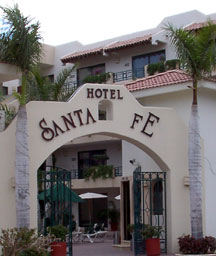
Today was a short haul south to Cabo San Lucas on the M1. Highway 19 is about an hour shorter, and I’ll take that north from Cabo on my way home. There are plenty of small towns to pull off and enjoy the sights on the M1. One of the nicest is Los Barriles, which is fast turning into another Cabo, although on a much smaller scale.
I rode through San José del Cabo on the way to Cabo San Lucas. To me they both appear overdeveloped. Traffic is a mess. The resort hotels have the beaches tied up. And so I retired to the quiet elegance of the Hotel Santa Fe, a five minute walk down Zaragoza to the main drag, Lazaro Cardenas.
At the Santa Fe rooms came with a fridge, a toaster oven, dishes and cutlery. There’s a small store, but prices are very high for gringos. My recommendation is to pick up what you need at the grocery store at the end of Zaragoza when you walk back to the Santa Fe.
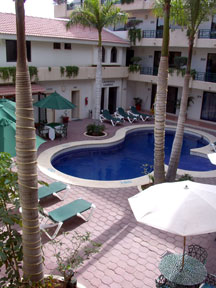
I was pleased to learn that it had on-site laundry — washed, dried and folded for 40 pesos. There’s also a taqueria where Mama fed me breakfast with a smile every morning and the price was only 40 pesos. Years ago I learned that even the simplest attempts to speak a foreign language was welcomed by the locals, and that was true here too. I think Mama was pleased with my fractured Spanish, for I got the local rates on the menu.
I got more than my fill of Cabo over the next several days. After all, there’s only so much to see and do in a tourist town. The malls are the same everywhere. The stores, the hawkers, the gawkers and the talkers populate every nook and cranny. Yet again every shop sells the same version of different trinkets, shirts and caps. Boats in the harbor are impressive, expensive and empty, their occupants having gone off to some hotel or another to enjoy the finer things they didn’t bring with them.
I had finally tired of the tourist nonsense and packed up to ride north. M19 runs north along the Pacific coast and it can be a little cool first thing in the morning. There’s fuel on the way out if you choose, or you can ride approximately 30 miles to Todos Santos and fuel there. After my early departure I decided to stop for breakfast in this tourist town.
Avoid the Hotel California
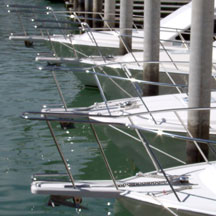
The Hotel California is decidedly a bad place to do that. The service was horrible and the meal less than so-so. When I finally got my “toast” it wasn’t even brown, but it was nice and hard. I wondered if it was yesterday’s bread leftovers.
There’s a legend floating around that the Hotel California is one and the same as sung about in the song. This isn’t true in the slightest and has in fact been denied by the band.
Across the street, the former owner of the Hotel California has a very nice place to eat – also called the Hotel California. I wish I had gone in there, but I had to sample the ambiance of the old Hotel. While the restaurant was in a very nice courtyard, it wasn’t worth the effort.
Don’t make the same mistake. Check out the place across the street.
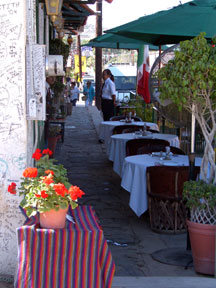
Todos Santos is just another tourist town on a much smaller scale than Cabo. It has become home to a variety of artists looking to escape the modern world. I checked out a small market just up the street, but found nothing remarkable. Just more of the same.
Back in the saddle again and I was headed for Loreto one more time. At the west end of La Paz there’s plenty of fuel all the way to the airport cutoff, so don’t be worried about turning off the highway and going into La Paz. The ride north was uneventful and boring.
After another overnight in Loreto I made a last minute decision to proceed to Santa Rosalia and take the ferry across to Guaymas and then head north to Nogales and the border.
I needed a vehicle permit to do that, but it was Sunday. After trying my Spanish out at the ferry office, the attendant called the local Banjercito girl to come in and write up a permit for me. She required photocopies of my passport, driver’s licence and insurance card, which I was able to provide. She also wanted a copy of my tourist visa, but since I had no copies of that, she consented to make one for me.
The Santa Rosalia ferry as of this writing (February 2006) is scheduled for Tuesday, Friday and Sunday night departures at 8 p.m., but after talking to a biker who had gotten off the late-arriving ferry I learned that the seas were very rough during his daylight crossing. This would delay the departure.
Motorcycles are loaded first, then the rest of the vehicles. After watching as the bike got strapped down, I headed up to my cabin hoping that I’d get a good night’s sleep. Unfortunately, that wasn’t to be the case. The scow listed badly from side to side in the rough sea crossing, and I was kept awake most of the night as we cruised across the Sea of Cortez. Needless to say, I was extremely happy to see the breakwater of Guaymas approaching at nine in the morning.
After a quick topoff in Guaymas, I rode north on the four-lane highway all the way to Nogales. The four-lane is in good condition, thanks to the tolls charged to use it.
The Hotel Flamingos is still there, on the right, just a bit north of Guaymas. Since I rode by in the early morning, I didn’t overnight on this trip, so I can’t say whether it’s still in good condition.
Upon entering Nogales, I was very surprised by the trucks waiting to enter the U.S. They were lined up for hundreds and hundreds and hundreds of feet, blocking all of the approach lanes to the border. I finally crossed over into the oncoming lanes to get past the trucks and into the car lanes. Apparently this is now standard procedure to get across the line at Nogales
While idling away in the lane, I witnessed a U.S. Border Patrol agent wrestle a pedestrian to the ground and escort him back to the Mexican side. I wonder what happened to his processing paperwork?
Welcome to America!
